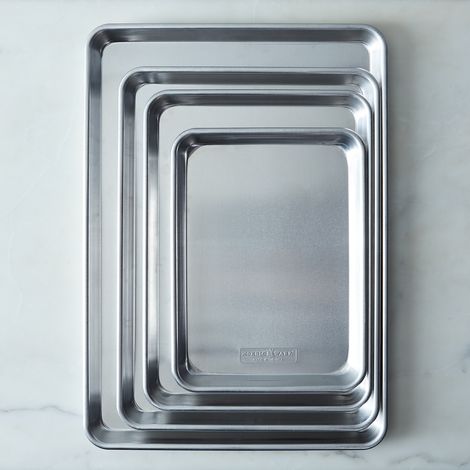Popular on Food52
Continue After Advertisement
12 Comments
Marika V.
February 27, 2018
Why ice water, takes more energy to produce the steam, boiling/hot water makes more sense.
mtnnewf
February 24, 2018
And, I'd add, all this is will change if you're baking at a high altitude or in a very dry atmosphere (or both, like in Colorado).
Mike E.
November 29, 2017
I recommend Jim Lahey's no-knead bread recipe, widely available on the internet. A very wet dough, baked in a pre-heated dutch oven, yeilds a crispy, chewey loaf.
Oscar C.
November 30, 2017
cosigning. when you figure out when the best time is to take the lid off your dutch oven, you get that satisfying crust with less hassle than the steam sheetpan method.
AntoniaJames
November 30, 2017
But the Dutch oven only allows you to bake a boule . . . . I have never had a baguette or batard crust that came close to the best crust on a boule. Occasionally however a baguette is preferred. The sheet pan method of adding steam is not particularly difficult, and well worth the effort. I might add that if my baguettes appear to have dried out a bit while rising (never a problem with boules rising in banettons), I spray generously with water after slicing the surface, right before baking. That makes a big difference, too.
For the record, I like the Tartine Bread recipes much more than Lahey's. ;o)
For the record, I like the Tartine Bread recipes much more than Lahey's. ;o)
Candy
November 29, 2017
"It also creates a crisp crust when the steam dissolves, leaving sugars to caramelize on the bread’s surface."
Very confused- the water is leaving sugars on the bread's surface? Or the steam dissolving onto the surface of the bread somehow does something causing the natural sugars in the dough's surface to be better caramelized than they would be without the water?
Very confused- the water is leaving sugars on the bread's surface? Or the steam dissolving onto the surface of the bread somehow does something causing the natural sugars in the dough's surface to be better caramelized than they would be without the water?
AntoniaJames
November 29, 2017
Good explanation here: http://www.slate.com/blogs/browbeat/2012/11/19/why_does_steam_make_bread_light_and_crusty_it_slows_down_the_cooking_process.html ;o)
AntoniaJames
November 29, 2017
Reduce by 20 minutes for convection loaves? Well, perhaps with some loaves. It depends on the weight and shape of the dough. Trust me on this. I use a convection oven and make bread using the steam creating method suggested on a regular basis. There is no single rule for reducing baking time. One must rely on appearance and more importantly, internal temperature taken with a reliable thermometer. Also, at least in the case of my oven, reducing the temperature by 25 degrees almost always adjusts correctly with little reduction in baking time needed. ;o)
Rebecca Z.
December 4, 2017
Temperature is key; and having a good idea of your target temperature, too. For low-moisture breads, this might be 180 to 190-degrees F, for high moisture breads, it's closer to 212, the boiling point. If you're not sure, and are willing to spend a few baking sessions on a recipe to work out its ideal temp., bake the first batch to 200F. If the bread's too dry, on your next baking day decrease the desire temp to 190, if it's too moist (meaning it's not quite coagulated), increase the internal temp. to 205 or even 210. Baker's percentages are a good starting point, breads that are over 75% hydration need a higher internal temp; breads below need a slightly lower temp, since there is less moisture to cook out with the residual heat after the loaf comes out of the oven.
When using a steam pan, it's also important to make sure that there's not too much water, so that after the first 10 min. of baking, the pan is dry; too much steam and the crust will never crips properly.
When using a steam pan, it's also important to make sure that there's not too much water, so that after the first 10 min. of baking, the pan is dry; too much steam and the crust will never crips properly.
bookjunky
November 29, 2017
I have never had any luck with making crunchy loaves. They come out of the oven nice and crisp but within a short time the crust has softened. Clearly there is too much moisture in the loaf but how to eliminate it without ending up with a dry and unpalatable bread?
Deedledum
November 30, 2017
Have you tried No-Knead Bread by Jim Lahey? It could also be the way you store your bread. Plastic's terrible for storage.





See what other Food52 readers are saying.